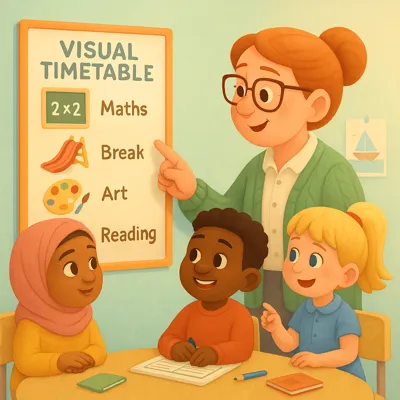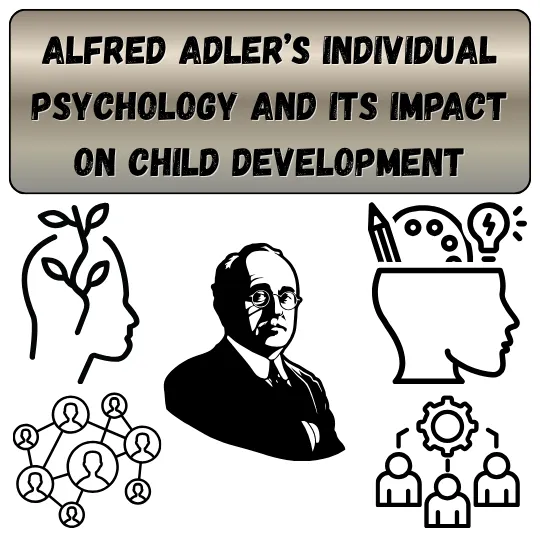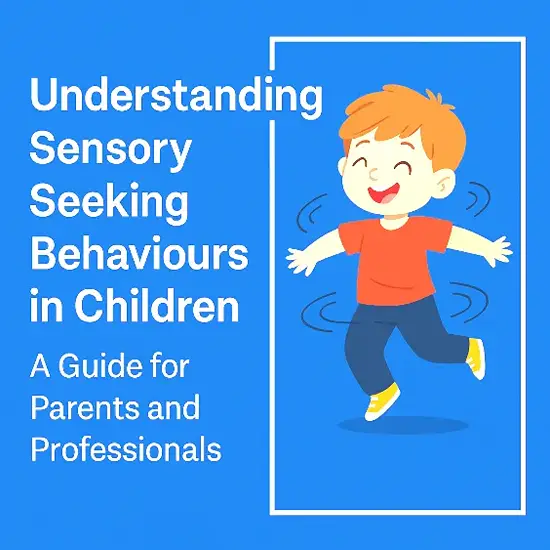Supporting Children and Young People with SEMH Needs
Supporting children and young people with Social, Emotional, and Mental Health (SEMH) needs can feel complex, especially when behaviours are challenging or emotions become overwhelming. However, with the right strategies in place, we can create environments where every child feels safe, seen, and supported.
Understanding what SEMH needs are and how they manifest is crucial. We recommend starting with our guide, What is SEMH and How to Meet SEMH Needs. This article builds on that foundation by exploring practical, relationship-based strategies that can be tailored to individual needs, both in educational settings and at home.
Build Strong, Trusting Relationships
Relationships are essential for effectively supporting children with SEMH needs (Bowlby, 1988; Hughes & Golding, 2012). They often thrive when they know that a consistent, calm adult is present who genuinely listens and cares about them.
To cultivate strong and trusting relationships, you should:
Be consistent
Show up reliably. Use a calm, predictable tone and respond in ways that the child can learn to anticipate and expect.
Trust develops when children know what to expect from you.
Listen with Full Attention
When a child is speaking, especially about their feelings, pause, make eye contact (if appropriate), and demonstrate that you are genuinely listening.
Validate Their Feelings
It's essential to validate a child's feelings, even if you disagree with their behaviour.
Acknowledge their emotions with phrases like, “That sounds really tough,” or “I can understand why you’d feel upset.”
Please just be curious, not critical.
Ask yourself, “What is this behaviour trying to tell me?” instead of, “Why are they doing this?”
Curiosity opens the door to connection.
Share Safe Parts of Yourself
It’s perfectly fine to say, “I felt nervous when I was your age too,” or “Sometimes I become overwhelmed and need a break.”
Sharing appropriately builds a connection.
Respect Their Boundaries
Some children may not want to talk, sit close, or engage right away.
Respecting their pace shows that you’re safe and not pressuring a connection.
Use gentle, affirming language.
Avoid labels like “naughty” or “attention-seeking.” Try using phrases such as: "You’re having a challenging moment," "Let’s figure this out together," or "I’m here when you’re ready."
Reframe attention-seeking as attention-needing to gain a fresh perspective.
Celebrate Small Successes
Acknowledge and identify positive behaviours or efforts.
A simple “Well done for trying” or “I noticed you remained calm during a tough situation” can make a significant difference.
Please show patience and forgiveness.
Relationships require time and understanding. There may be setbacks, but remaining calm and providing a fresh start each day helps cultivate trust and confidence.
Be Emotionally Available
Children with SEMH needs often test if adults are emotionally present.
It's crucial to continue to show up, even when it’s complicated, to maintain a strong emotional connection.
Create Predictable, Supportive Environments
Children who feel emotionally safe are better able to engage in learning and relationships (Perry, 2006). Therefore, creating a calm, structured environment can help reduce triggers and provide children with a sense of control (National Autistic Society, 2023). Environments that allow children to fail without experiencing shame will help them feel safe and secure while fostering resilience.

Furthermore, safe, supportive, and predictable environments reduce anxiety, promote trust, and enhance emotional well-being. To create these environments, you should:
Establish Clear Routines
Utilise consistent daily rhythms (e.g., "first we do ___, then ___") and include visual timetables, checklists, or 'now and next' cards to help diminish uncertainty.
Preparing children for changes in advance, whenever possible, can further help alleviate uncertainty.
Create Calm Physical Spaces
You can use soft lighting, organised layouts, and soothing colours whenever feasible. Create a quiet area, also known as a "calm corner," with cushions, books, or sensory items to provide a peaceful space.
Minimise clutter and overstimulating displays, particularly for children with neurodiversity, to prevent sensory overload.
Use Gentle, Clear Language
Please speak in a calm tone, using short, simple sentences, and ask a clarifying question afterwards to make sure your instruction or information has been correctly received and understood.
Offer choices to promote a sense of control: Would you like to work at the table or on the floor? “I wonder” questions can also be used: “I wonder if Alex would like to work on the table or the floor?”
Avoid shouting or raising your voice—even when setting limits. Loud voices and noises can trigger past traumas and provoke a fight-or-flight response.
Make Expectations Visible
Utilise visual rules or social stories to illustrate expectations. Expectations can also be established as a class charter as part of a Rights-Respecting Classroom.
Praise children's efforts when they adhere to routines or expectations. Role-playing or modelling routines (e.g., lining up, requesting help, taking turns) can help reinforce this more effectively for visual learners.
Offer Safe, Predictable Responses
Respond consistently to behaviour—don’t alternate between being overly strict and overly lenient. Consistency fosters predictability, enabling children to feel more secure and confident. This is where personal growth and development occur.
If a boundary is crossed, follow up calmly and explain why. Allow for reflection time to give the child the opportunity to make things right.
Plan for Transitions and Change
Provide 5–2–1-minute warnings before concluding an activity. Visual timers or sand timers can be particularly beneficial for children with neurodiversity. An established transition song can also help reduce anxiety associated with change.
For more significant changes (e.g., moving to a new school, observing holidays, school trips), consider using visual countdowns, storybooks, or in-person visits. When planning a school outing, consider using Google Maps to help the children visualise the environment and what they might encounter.
Respond to Emotional Needs, Not Just Behaviour
If a child is dysregulated, focus on calming them first rather than correcting their behaviour. Trying to fix a dysregulated child rarely ends positively and usually results in escalating behaviour.
Use co-regulation: “Let’s take a deep breath together,” or “I’ll sit with you until you feel ready to continue.” Co-regulation not only helps the child or young person regulate themselves but also fosters trust and a sense of safety.
Reflect together later when emotions have settled to understand the cause of the behaviour and create strategies that might support them next time. This is a good time to repair relationships that might have been damaged due to the behaviour.
Emotional Literacy for Children with SEN
Many children with SEMH needs struggle to identify or express their feelings. Teaching emotional literacy equips students with the tools to understand and convey their emotions (Goleman, 1995; CASEL, 2024), thus supporting their social and emotional development.

Create a Safe and Supportive Environment:
Ensure that the environment is safe, predictable, and supportive.
This helps young people feel secure and more willing to express their emotions.
Teach Emotional Vocabulary
Help young people develop a rich emotional vocabulary. This can be done through activities that encourage them to identify and label their emotions.
Using tools like emotion wheels or charts can be very effective.
Model Emotional Literacy
Adults should model appropriate emotional expression and regulation.
Demonstrating how to handle emotions healthily provides a powerful example for young people to follow.
Use Stories and Role-Playing
Stories and role-playing can be excellent tools for teaching emotional literacy. They enable young people to explore various emotions and scenarios in a safe and controlled manner.
Encourage Reflection
Provide opportunities for young people to reflect on their emotions and experiences.
This can be achieved through journaling, discussions, or creative activities such as drawing or music.
Develop Social Skills
Social skills training can help young people with SEMH needs to better understand and manage their emotions in social contexts.
This includes teaching skills like empathy, active listening, and conflict resolution.
Collaborate with Professionals
Partner with schools, speech-language therapists, psychologists, and other relevant professionals to provide targeted support and interventions.
Incorporate Mindfulness and Relaxation Techniques
Techniques such as mindfulness, deep breathing, and relaxation exercises can help young people manage stress and regulate their emotions.
Provide Consistent Feedback and Support
Regular, constructive feedback helps young people understand the impact of their emotions and behaviours, and supports their emotional growth.
Children need to learn what helps them feel calmer and more in control (Siegel, 2013). This won’t happen in the middle of a meltdown – it’s something to teach over time, with patience.
The Zones of Regulation (Kuypers, 2011) is a widely used framework that helps pupils identify and manage their emotions through colour-coded zones.
Explicit Teaching of Regulation Strategies
Identify Triggers: Help students recognise what triggers their emotional responses. This can be accomplished through discussions, journaling, or the use of visual aids.
Teach Coping Mechanisms: Introduce various coping strategies such as deep breathing, counting to ten, or using stress balls. Practice these techniques regularly.
Use Visual Supports: Tools such as emotion charts, traffic light systems, or the Zones of Regulation can help students understand and manage their emotions.
Modelling Regulation Strategies
Demonstrate Calmness: Teach students how to remain calm during stressful situations. Use techniques such as deep breathing or positive self-talk, and clarify what you are doing and why.
Share Personal Experiences: When appropriate, talk about how you manage your emotions. This approach can help make the strategies more relatable and comprehensible.
Consistent Practice: Regularly practice regulation strategies in various environments, not solely during times of distress. This helps students incorporate these strategies into their daily routines.
Create a Supportive Environment
Safe Spaces: Offer a designated area where students can go to calm down and practice their regulation strategies.
Positive Reinforcement: Encourage and praise students when they effectively use regulation strategies. This reinforces their usage and builds confidence.
Collaborative Approach: Collaborate with other staff, parents, and professionals to ensure a consistent method for teaching and modelling regulation strategies.
Incorporate Mindfulness and Relaxation Techniques:
Mindfulness Exercises: Teach practices such as meditation or mindful breathing to help pupils stay present and manage their emotions effectively.
Relaxation Techniques: Introduce methods such as progressive muscle relaxation or guided imagery, which can be particularly helpful during times of high stress.
Plan Support Around Strengths
While it’s essential to acknowledge challenges, focusing on a child’s strengths can help build confidence and self-worth. (Seligman, 2002; Saleebey, 1996)
Planning support around the strengths of children with SEMH (Social, Emotional, and Mental Health) needs can be highly effective in promoting their development and well-being. Here are some strategies to consider:
Identify Individual Strengths
Strengths Assessment: Utilize tools such as strength-based assessments or questionnaires to identify each child's unique strengths and interests.
Observation: Spend time observing the child in different settings to understand their natural abilities and preferences.
Personalised Learning Plans
Tailored Goals: Set personalised goals that leverage the child's strengths. This can help them feel more confident and motivated.
Flexible Curriculum: Adapt the curriculum to include activities that align with the child's strengths and interests.
Positive Reinforcement
Celebrate Successes: Regularly acknowledge and celebrate the child's achievements, no matter how small. This boosts their self-esteem and encourages them to exhibit positive behaviour.
Constructive Feedback: Provide constructive feedback that focuses on what the child did well and how they can build on their strengths.
Strength-Based Activities
Engaging Projects: Incorporate projects and activities that utilise the child's strengths. For example, if a child excels in art, include creative projects in their learning plan.
Peer Collaboration: Encourage collaboration with peers in areas where the child feels confident and comfortable. This can enhance social skills and provide a sense of accomplishment.
Supportive Environment
Safe Spaces: Create a supportive and secure environment where children feel comfortable expressing themselves and exploring their strengths.
Consistent Routines: Establishing consistent routines provides stability and predictability, helping the child feel secure.
Professional Collaboration:
Multi-Disciplinary Team: Work with a team of professionals, including educators, therapists, and psychologists, to develop a comprehensive support plan that focuses on the child's strengths.
Regular Reviews: Conduct regular reviews of the child's progress and adjust the support plan as needed to ensure it continues to align with their strengths.
Work in Partnership to Create a Supportive Network
No one knows a child better than their family. Working together creates more consistent support and helps children feel understood across settings.
Working in partnership with families and professionals is crucial for effectively supporting children (Epstein, 2001; DfE, 2015) with Social, Emotional, and Mental Health (SEMH) needs. Here are some strategies to foster collaboration:
Open Communication
Regular Updates: Keep families informed about their child's progress and any changes in their support plan. This can be done through regular meetings, emails, or phone calls.
Listening to Concerns: Encourage families to share their concerns and insights. This helps build trust and ensures that their perspectives are taken into consideration in the support plan.
Collaborative Planning
Involve Families in Decision-Making: Include parents and carers in the planning and decision-making process. Their input is invaluable in creating a holistic support plan that addresses the child's needs.
Multi-Disciplinary Teams: Work with a team of professionals, including educators, therapists, and psychologists, to develop and implement support strategies. This ensures a comprehensive approach to the child's SEMH needs.
Parent Support Groups
Facilitate Parent Groups: Create or connect families with parent support groups where they can share experiences, strategies, and resources. These groups provide emotional support and practical advice.
Workshops and Training: Offer workshops and training sessions for parents to help them understand the needs of children with SEMH and learn practical strategies to support their children.
Consistency and Continuity
Consistent Strategies: Ensure that the strategies used at school are reinforced at home. This consistency helps the child feel secure and supports their development.
Regular Reviews: Conduct regular reviews of the child's progress with families and professionals to adjust the support plan as needed.
Empower Families
Provide Resources: Share resources and information with families to help them support their child's SEMH needs effectively. This can include books, websites, and contact information for local support services.
Encourage Participation: Encourage families to actively participate in their child's education and therapeutic activities. This involvement can significantly enhance the effectiveness of interventions.
Supporting SEMH needs can be emotionally demanding. Adults need space and support, too.
Supporting staff wellbeing and providing adequate training are essential (PHE, 2019; NICE, 2018) for creating a positive and productive environment, especially when working with children with SEMH needs. Here are some strategies:
Promote a Positive Work Environment
Open Communication: Foster open and honest communication among staff members. Regular check-ins and team meetings can help staff feel supported and valued.
Recognition and Appreciation: Regularly acknowledge and celebrate staff achievements and efforts. This can boost morale and create a positive atmosphere.
Provide Access to Mental Health Resources:
Counselling Services: Offer access to counselling services or employee assistance programs, allowing staff to seek support for their mental health.
Stress Management Workshops: Conduct workshops on stress management techniques, mindfulness, and relaxation exercises.
Professional Development and Training:
Regular Training Sessions: Offer ongoing training on SEMH strategies, including techniques for identifying and supporting children with SEMH needs.
Skill Development: Offer training that emphasizes developing essential skills, including emotional literacy, conflict resolution, and effective communication.
Create a Supportive Community:
Peer Support Groups: Establish peer support groups where staff can share experiences, challenges, and strategies. This fosters a sense of community and mutual support.
Mentorship Programs: Implement mentorship programs that provide experienced staff with the opportunity to guide and support their newer colleagues.
Work-Life Balance:
Flexible Working Hours: Offer flexible working hours or remote work options to help staff balance their professional and personal lives.
Encourage Breaks: Ensure staff take regular breaks and have time to recharge during the workday.
Health and Wellness Programs:
Physical Health Initiatives: Promote physical health through initiatives like fitness classes, healthy eating programs, and wellness challenges.
Mindfulness and Relaxation: Incorporate mindfulness practices and relaxation techniques into your daily routine to help staff manage stress effectively.
Regular Feedback and Evaluation:
Constructive Feedback: Provide regular, constructive feedback to help staff improve and feel valued.
Evaluation and Adjustment: Regularly evaluate the effectiveness of wellbeing and training programs and adjust as needed.
Final Thoughts
Supporting children and young people with SEMH needs is not about having all the answers—it's about being present, consistent, and willing to learn alongside them.
When we focus on connection before correction, prioritise emotional safety, and celebrate small steps forward, we create space for healing, growth, and resilience.
Every child is unique, as is their journey. By collaborating—families, educators, professionals, and communities—we can provide support that sees beyond behaviours and nurtures the whole person.
With patience, compassion, and a strengths-based approach, we can help children not only cope but truly thrive.


